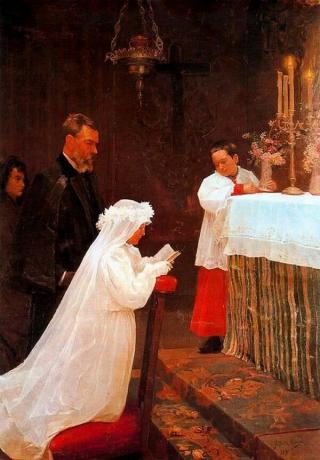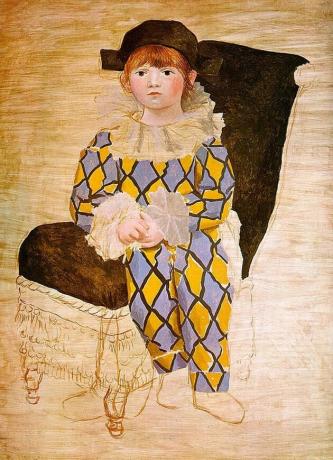Picasso: 13 essential works to understand the Spanish genius
Pablo Picasso was a Spanish painter, sculptor, poet, potter, playwright and set designer. He spent most of his adult life in Paris, where he befriended various artists. Picasso was one of the founders of Cubism and one of the great art revolutionaries at the beginning of the 20th century.
These are the thirteen essential works to understand Picasso taking into account all his artistic phases.
1. First Communion (1896)

Picasso's first phase predates 1900. In this phase are the paintings that express the first searches for him, such as this oil on canvas, painted when Picasso frequented the La Lonja School of Arts.
The work was exhibited in Barcelona and attracted the attention of the local press. It was made in accordance with the precepts of realism from the late nineteenth century. The painting depicts his sister, Lola, during First Communion, a solemn moment of transition from childhood to adult life in the Catholic faith.
2. Life (1903) - Blue stage

Life it is one of the most important paintings of the so-called blue stage. Between 1901 and 1904, Picasso emphasized works with blue tones and themes such as prostitutes and drunks.
This phase was inspired by a trip to Spain and by the suicide of his friend Carlos Casagemas, who was posthumously portrayed in this painting.
During the blue period, Picasso went through financial difficulties, alternating his stay between Paris and Madrid.
3. Garçon à la pipe (1905) - Pink stage

Picado's pink stage was determined by the use of lighter, warmer and lighter tones, mainly pink. In this period, which he spanned from 1904 to 1906, Picasso lived in Paris, in the bohemian district of Montmartre. Life in the region also influenced the painter, who portrayed many acrobats, dancers, and harlequins. It was also at this time that Picasso met the writer Gertrude Stein, who became one of his great clients.
4. Gertrude stein (1905) - Pink stage / primitivism

Gertrude Stein commissioned the portrait of her from Picasso. She had become a friend of the painter and one of the most important funders of his works. The portrait of Gertrudis corresponds to a transition between the pink stage and primitivism. In his face we can perceive the influence of the African masks that will accompany him in his next stage.
5. The damsels of Avignon (1907) - African or primitivist stage

This painting marks the beginning of the period in which Picasso was greatly influenced by African art, and lasted between 1907 and 1909. Despite the fact that Iberian art is present in the painting, it is possible to clearly see the references to Africa. Mainly, in the composition of the faces of the two women on the right side of the painting. Her faces are similar to African masks. Picasso only exhibited this painting years later in 1916.
6. Portrait of Daniel-Henry Kahnweiler (1910) - Stage of analytical cubism

Picasso developed together with George Braque a new style of painting: Analytical Cubism (1909-1912). The artists sought to analyze the object in its terms and forms. The color palette was monochromatic and preferably neutral. In this work, Picasso portrayed Daniel-Henry Kahnweiler, owner of an art gallery in Paris. With this painting, Picasso changed the way of portraying and thus broke with tradition.
7. Head (1913) - Synthetic Cubism

Synthetic Cubism (1912-1919) was a development of Cubism. Picasso began to use pieces of paper, such as wallpaper and newspaper in his works. He was one of the first to use the technique of collage in his works.
During this period, the painter was always in contact with various artists in Paris, such as André Breton and the writer Apollinaire. With the end of the First World War, Picasso met more people, such as the filmmaker Jean Cocteau and the composer Igor Stravinsky.
Contact with numerous artists from different areas influenced the artistic style of the painter, which he went through various experiments in the following years.
8. Paulo as a harlequin (1924) - Neoclassicism and Surrealism

Picasso had a very large and extensive production. This portrait of his son as a harlequin is inserted in the neoclassic-surrealist phase (1919-1929). With the end of the war, many European artists looked within classicism for a way to restore order. At the same time, the artistic avant-gardes continued to make their mark.
9. Still life (1924) - Neoclassicism and Surrealism

This still life, painted the same year as the canvas of Paulo as a harlequin, demonstrates the versatility of the artist. Picasso goes from a representative drawing to a great exercise in abstraction.
10. The artist and his model (1928) - Neoclassicism and Surrealism

In 1925, the writer André Breton, the great ideologue of Surrealism, declared that Picasso was one of them. Even though Picasso did not follow to the letter the precepts of that movement, he was present at the group's first exhibition in 1925 with cubist works.
11. Guernica (1937) - The great depression and the exhibition at the MOMA

Guernica is the most famous work of Picasso and Cubism. It represents the bombing that the Nazis perpetrated against that Basque city during the Spanish Civil War. During the period from 1930 to 1939 the constant figures of the harlequin in Picasso's work were replaced by the minotaur. Picasso's paintings turned gloomy, appealing to the use of pastel colors.
See also: Meaning and analysis of Pablo Picasso's painting Guernica
12. Bust of woman with hat with flowers (1942) - World War II

Picasso stayed in Paris during the Nazi occupation of World War II. In this period, the artist participated in many exhibitions and received some visits from the political police of the fascist regime. By the end of the 1940s, Picasso was already a celebrity and both his work and his personal life were of general interest.
13. Crossed hands jaqueline (1954) - Late works

Between 1949 to 1973 the final works and the late works of Picasso are included. In this period, the artist is already a consecrated painter. Many of his paintings are portraits of his wife Jaqueline. He also made various sculptures, including a giant structure known as Chicago Picasso. In 1955 he helped filmmaker Henri-Georges Clouzot make a film about his life called The mystery of Picasso.
About Pablo Picasso
Picasso was born in 1881, in Malaga, Andalusia, where he lived for about 10 years. His father was a drawing teacher at the San Telmo School. At age 7, Picasso began taking classes from his father, who believed that technique was essential for a good artist.
When Picasso was 13 years old, his father understood that he had already surpassed him in painting. Thus, he made him enter the La Loja School of Arts in Barcelona.
At age 16, Picasso was sent to the San Fernando Royal Academy of Fine Arts in Madrid. The young painter spent most of his time in the Prado Museum copying great works of art instead of going to classes.
In 1900, at the age of 19, Picasso went to Paris for the first time, a city in which he would spend most of his life. There he met various artists with whom he lived, such as André Breton, Guillaume Apollinaire and the writer Gertrude Stein.



